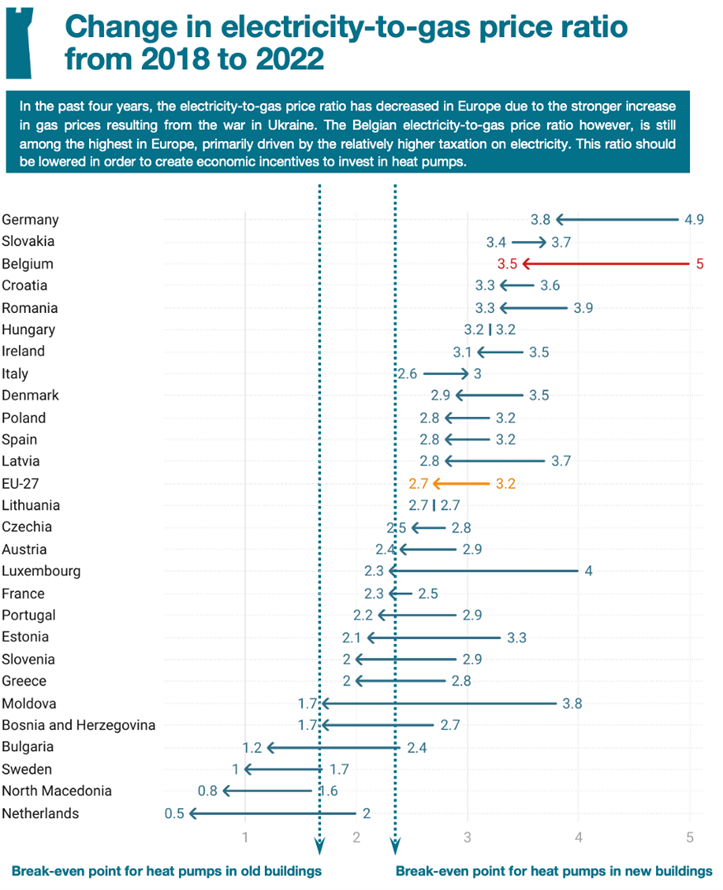Kristof graduated as a Master of Business Engineering at the University of Antwerp in 2018 (major in Corporate Finance and Financial engineering). In his master thesis, he examined the profitability of a momentum strategy on various government bond markets. Kristof joined the team of Econopolis as a Business Analyst in September 2018, focusing on data management and the follow-up of the latest wealth management technologies. Since 2020 Kristof, became Senior Consultant within Econopolis Consulting, a strategic advisory services with a focus on climate and energy transition.
Never waste a good crisis: it is time for Belgium to lock-in the tumbling electricity-to-gas price ratio
In our country, the primary method of heating our buildings is through the combustions of oil or gas. Unfortunately, this reliance on fossil fuels leads to a significant contribution of nearly 20% to our national emissions each year. As such we are faced with the formidable challenge of transitioning to greener heating methods, which involves comprehensive building renovations, the utilization of industrial waste heat, and the installation of heat pumps. It's a completely new way of heating.
One particularly promising solution in this regard is the use of heat pumps on a large-scale. But what exactly is a heat pump? Essentially, a heat pump efficiently transfers heat from the air, ground, or water to warm our homes, operating entirely on electricity. In fact, a heat pump typically produces 4 kWh of heat for every 1 kWh of electricity consumed. Even if a heat pump is powered by electricity generated from natural gas, it remains more climate-friendly than a gas condensing boiler due to its high efficiency.
However, a significant drawback of heat pumps is that their efficiency[1] decreases rapidly in poorly insulated buildings. This means that you get less useful heat for the same amount of power in such buildings. For new buildings, a heat pump is often an obvious choice because its efficiency is high enough to compensate for the higher electricity prices compared to gas prices. For existing homes, it's not as straightforward, and in many cases, deep energy renovations are recommended first, in order to improve insulation and overall energy efficiency.
So, how can we kickstart the deployment of sustainable alternatives? An important aspect of this transition is that it can only reach full speed, if you provide individuals with economic incentives, encouraging them to choose sustainable options. The shift towards electrification will only be economically viable when the cost of electrical energy becomes relatively cheaper compared to that of energy from fossil fuel alternatives. Recent events, such as the Russian invasion in Ukraine, have triggered a shift in Europe due to soaring gas prices reaching unprecedented levels. These prices are expected to remain high, marking a crucial turning point that has stimulated the adoption of heat pumps. This trend is evident in Belgium as well, with heat pump sales doubling in 2022 compared to the previous year.
However, in order to solidify this electrification trend on a long-term basis, we need a comprehensive policy that addresses the price discrepancy between gas and electricity. Currently, such a policy is lacking, particularly in terms of fiscal measures. The taxation imposed on electricity is comparatively higher than that on fossil fuels. As a result, electricity in Belgium remains relatively expensive in comparison to fossil fuels, especially when compared to other countries. This is clearly illustrated by the graph below, which highlights that the Belgian electricity-to-gas price ratio[2] is among the highest in Europe, primarily driven by the relatively higher taxation on electricity.

Source: Eurostat, Econopolis model to calculate the break-even points[3]
Price incentives are indeed vital for the success of our transition towards sustainable solutions. By redistributing the tax burden from electricity to fossil fuels, we can effectively create the necessary incentives for consumers to make investments in deep energy renovations and adopt heat pumps. Only then can we achieve a transition at full speed.
_______________________________________
[1] The efficiency of a heat pump is expressed in COP or Coefficient of Performance. It indicates the amount of kWh of heat delivered per kWh of electricity consumed.
[2] Including all taxes and levies
[3] The break-even point was defined as the electricity-to-gas price ratio at which a payback period of 15 years was assumed (heat pump vs. gas condensing boiler). A higher ratio is less beneficial for the heat pump case and will therefore increase the payback period. This point is higher for new buildings or deeply renovated buildings, as the higher efficiency results in a smaller price gap needed between power and gas. Break-even points were calculated for the Belgian climate and the Belgian state of the building stock.